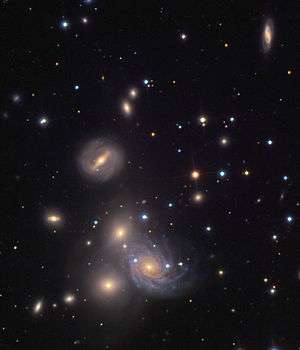NGC 72
| NGC 72 | |
|---|---|
|
NGC 72, located over the central NGC 68 group. | |
| Observation data (J2000.0 epoch) | |
| Constellation | Andromeda |
| Right ascension | 00h 18m 28.4s |
| Declination | +30h 02m 26.5s |
| Redshift | 0.024213[1] |
| Helio radial velocity | 7259 km/s[1] |
| Distance | 320-325 Mly[2][3] |
| Apparent magnitude (V) | 13.5[4][2] |
| Characteristics | |
| Type | Sb[5] Sbc[4] SA(rs)c[2] |
| Size | 180,000[2] |
| Apparent size (V) | ~1.3'x1.0'[5][4][6] |
| Other designations | |
| UGC 176, ARP 113, VV 166d, MCG +05-01-069, 2MASX J00182837+3002265, 2MASXi J00182837+3002265, PGC 001204 | |
NGC 72 is a barred spiral galaxy estimated to be about 320 million light-years away in the constellation of Andromeda. It was discovered by R. J. Mitchell in 1855 and its magnitude is 13.5.[7]
References
- 1 2 "NASA/IPAC Extragalactic Database - NGC 72". NED. NASA/IPAC. Retrieved 14 March 2015.
- 1 2 3 4 Seligman, Courtney. "New General Catalog Objects: NGC 50 - 99". cseligman.com. Retrieved 14 March 2015.
- ↑ Wright, Ned. "Ned Wright's Javascript Cosmology Calculator". http://www.astro.ucla.edu. UCLA. Retrieved 23 November 2014. External link in
|website=(help) - 1 2 3 "NGC 72 >> Deep Sky Object Browser". Deep Sky Objects Browser. Retrieved 14 March 2015.
- 1 2 "NGC 72 - Simbad". http://simbad.u-strasbg.fr. Stratsbourg Astronomical Data Center. Retrieved 14 March 2015. External link in
|website=(help) - ↑ "WIKISKY - NGC 72". wikisky. SKY-MAP.org. Retrieved 23 November 2014.
- ↑ "NGC Objects: NGC 50 - 99".
This article is issued from Wikipedia - version of the 6/27/2016. The text is available under the Creative Commons Attribution/Share Alike but additional terms may apply for the media files.
